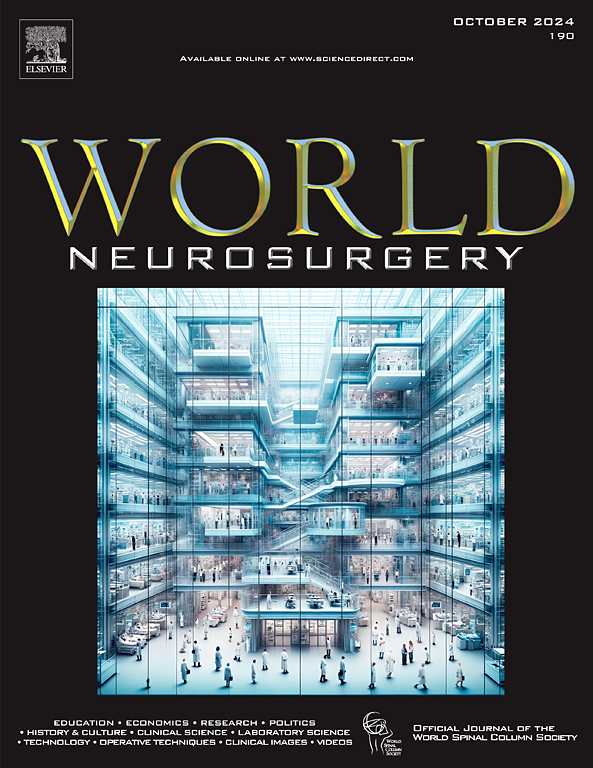特发性正压脑积水与每种瓣膜类型的分流并发症:比例荟萃分析。
IF 1.9
4区 医学
Q3 CLINICAL NEUROLOGY
引用次数: 0
摘要
背景:特发性正常压力脑积水的典型特征是步态障碍、认知功能障碍和尿失禁。由于心室分流可能受到瓣膜类型的影响,我们进行了一项荟萃分析来评估瓣膜特征与预后之间的关系。方法:纳入报道瓣膜类型、结局和相关并发症的英文研究。数据提取和分析使用R,版本4.3.2。结果:纳入13项研究。采用重力瓣膜治疗硬膜下积液(SDEs)的meta分析结果为0.04[0.02,0.07],手术治疗SDEs的meta分析结果为0.00[0.00,0.00],近端修复的meta分析结果为0.06[0.03,0.09],远端修复的meta分析结果为0.06[0.03,0.09]。采用反虹吸控制的差压阀(DPVs), meta分析显示SDEs的发生率为0.10[0.07,0.13],手术SDEs的发生率为0.02[0.01,0.04],近端修复的发生率为0.03[0.01,0.05],远端修复的发生率为0.04[0.02,0.07]。在没有反虹吸控制的dpv中,SDEs的发生率为0.17[0.11,0.23],手术SDEs的发生率为0.11[0.06,0.19],近端分流器修复的发生率为0.00[0.00,0.02],远端分流器修复的发生率为0.05[0.02,0.10]。使用流量调节阀,SDEs的发生率为0.05[0.01,0.12],手术SDEs的发生率为0.01[0.00,0.05],近端翻修的发生率为0.06[0.02,0.11],远端翻修的发生率为0.01[0.00,0.05]。结论:重力瓣和npv与SDEs相关较少,而伴和不伴asd的DPVs与SDEs相关较多,近端和远端修复无差异。本文章由计算机程序翻译,如有差异,请以英文原文为准。
Idiopathic Normal Pressure Hydrocephalus and Shunt Complications per Valve Type: A Meta-Analysis of Proportions
Background
Idiopathic normal pressure hydrocephalus is classically recognized by the triad of gait disturbance, cognitive dysfunction, and urinary incontinence. Since ventricular shunting may be affected by valve type, we conducted a meta-analysis to assess the relationship between valve characteristics and outcomes.
Methods
English language studies that reported valve types, outcomes, and associated complications were included. Data were extracted and analyzed using R, version 4.3.2.
Results
Thirteen studies were included. With gravitational valves, meta-analysis yielded 0.04 [0.02, 0.07] for subdural effusions (SDEs), 0.00 [0.00, 0.00] for surgical SDEs, 0.06 [0.03, 0.09] for proximal revisions, and 0.06 [0.03, 0.09] for distal. With differential pressure valves (DPVs) with antisiphon control, meta-analysis showed an incidence of 0.10 [0.07, 0.13] for SDEs, 0.02 [0.01, 0.04] for surgical SDEs, 0.03 [0.01, 0.05] for proximal and 0.04 [0.02, 0.07] for distal revisions. With DPVs without antisiphon control, there was an incidence of 0.17 [0.11, 0.23] for SDEs, 0.11 [0.06, 0.19] for surgical SDEs, 0.00 [0.00, 0.02] for proximal shunt revisions, and 0.05 [0.02, 0.10] for distal shunt revisions. With flow regulated valves, there was an incidence of 0.05 [0.01, 0.12] for SDEs, 0.01 [0.00, 0.05] for surgical SDEs, 0.06 [0.02, 0.11] for proximal revisions, and 0.01 [0.00, 0.05] for distal.
Conclusions
Gravitational valves and NPVs are associated with fewer SDEs while DPVs with and without ASDs are associated with more while there were no differences in proximal or distal revisions.
求助全文
通过发布文献求助,成功后即可免费获取论文全文。
去求助
来源期刊

World neurosurgery
CLINICAL NEUROLOGY-SURGERY
CiteScore
3.90
自引率
15.00%
发文量
1765
审稿时长
47 days
期刊介绍:
World Neurosurgery has an open access mirror journal World Neurosurgery: X, sharing the same aims and scope, editorial team, submission system and rigorous peer review.
The journal''s mission is to:
-To provide a first-class international forum and a 2-way conduit for dialogue that is relevant to neurosurgeons and providers who care for neurosurgery patients. The categories of the exchanged information include clinical and basic science, as well as global information that provide social, political, educational, economic, cultural or societal insights and knowledge that are of significance and relevance to worldwide neurosurgery patient care.
-To act as a primary intellectual catalyst for the stimulation of creativity, the creation of new knowledge, and the enhancement of quality neurosurgical care worldwide.
-To provide a forum for communication that enriches the lives of all neurosurgeons and their colleagues; and, in so doing, enriches the lives of their patients.
Topics to be addressed in World Neurosurgery include: EDUCATION, ECONOMICS, RESEARCH, POLITICS, HISTORY, CULTURE, CLINICAL SCIENCE, LABORATORY SCIENCE, TECHNOLOGY, OPERATIVE TECHNIQUES, CLINICAL IMAGES, VIDEOS
 求助内容:
求助内容: 应助结果提醒方式:
应助结果提醒方式:


